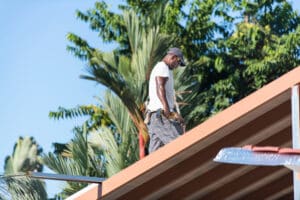When deciding on the best wood for underwater usage, there are a few things to keep in mind to guarantee durability and resilience.
In this blog post, we will delve into lumber options suitable for various marine applications and wet environments, preparing wood for marine use, maintaining wood integrity over time, and understanding the right wood treatments approved for marine construction.
Choosing the Ideal Wood for Underwater Use and Wet Environments
One of the most important factors to consider when choosing wood for underwater or outdoor use is its ability to resist water damage.
If the wood will be submerged in water, choosing a type of durable wood species naturally resistant to rot and decay is essential. If the wood will be used above the water’s surface but exposed to severe weather, other factors like weather resistance and durability may also be of importance.
Consider things like water temp, salinity levels, and exposure to the sun or other elements to help craft your project with materials that are made for enduring extreme conditions.
Western Softwoods

Western Red Cedar, Pacific and Coast Douglas Fir, and Redwood are three wood types commonly used for underwater construction projects. These woods are known for their stability and high resistance to decay, making them ideal for use in hard-wearing marine environments.
Exotic Hardwoods

Some popular options for hardwoods include Ipe, Cumaru, Tigerwood, and Garapa. These woods have a natural resistance to rot, decay, and marine organisms that live in humid environments. In addition, they are durable and have high strength-to-weight ratios, making them ideal for constructing docks, piers, and other structures in marine environments.
Ipe, or Brazilian Walnut, is known for its natural durability, density, and hardness. Its beauty and incredible weathering abilities make it an ideal choice for various marine construction projects. Because it’s so dense, however, Ipe is a heavy wood and more challenging to work with than pressure-treated wood. But because it’s low maintenance, the quality of this material is worth the extra time and effort you’d spend on initial installation.
While no wood actually gets stronger in water per se, certain wood species, such as African Teak, have unique properties that make them more stable when exposed to moisture. This stability helps maintain structural integrity even after prolonged contact with water, which could give an impression of increased strength compared to other less resilient materials.
Durable Pressure-Treated Lumber
Before some species of timber can be exposed to water and other natural elements, they need to be treated. When treated properly and maintained, natural wood piling can last decades.
Pressure treatment is a process that fortifies natural lumber against mold, rot, and pest infestations. Lumber is put in a pressurized, vacuum-sealed chamber and then exposed to a chemical treatment that penetrates deep into the wood. The most common chemical used is copper, which gives pressure-treated lumber that famous green tint.
Not all pressure treatments are the same. For example, some are only cleared for freshwater use and can’t withstand contact with salt water. Using freshwater-only lumber on an oceanside boat dock would be disastrous within a few short years or even months. Also, not all treatments are meant for contact with the ground.
Using improperly treated lumber is terrible for the wood, the environment, and your wallet. Before you buy wood, make sure the treatment is suited for your home waters.
Chemical treatment levels affect how long wood will last in marine or other harsh environments. Always look at the tags on the end of the boards. If you are building near water or ground level, look for wood approved for ground contact. If you are building on or near salt water, you should look for wood treated for marine-grade environments.
At most big box stores, the boards are not meant for use near salt water or harsh marine environments – check with us to make the correct selection of timber for use in aquatic settings.
Active Ingredients in Treated Wood: MCA, CA, ACQ, and CCA
To prepare it for harsh marine environments, wood can be pressure treated with a combination of water and preservatives to discourage insect infestation and slow decay. Different preservatives are suited for various applications and types of wood for water resistance. Some of the most common treatments you’ll see for marine lumber are:
MCA (Micronized Copper Azole) and CA (Copper Azole)
These are copper-based preservatives suitable for above-ground, below-ground, and freshwater uses. These treatments penetrate deep into lumber to prevent rot from water exposure and pests.
ACQ (Alkaline Copper Quaternary)
ACQ contains a quaternary compound, including copper and ammonium. As a result, ACQ is strong against fungi, insects, and other marine creatures that may damage your lumber.
CCA (Chromated Copper Arsenate)
CCA combines chromium, copper, and arsenic for maximum protection. Because of its chemical content, CCA is approved for marine construction and boat docks but not for most residential applications (like homes, fences, or furniture).
These treatments are water-based, so the treatment thoroughly penetrates the lumber while still allowing the application of paint and finish.
Waterlogging
Talk about underwater treasure!
One of the growing trends in sourcing wood for marine construction is underwater logging, which is the process of retrieving trees from underwater forests or salvaging logs that have been abandoned after they’ve become waterlogged and sank. Wood is often preserved when trees die from areas with manmade reservoirs and dams, and this “rediscovered wood” can be retrieved with special underwater machinery.
Underwater wood has been preserved from wood-decaying fungi that need wood, moisture, air, and temperatures around 75 to 90 degrees to survive. They are also safe from stains.
Some of the wood that has been found includes wood that’s been difficult to source: Myrtle, Black Wood, Celery Top Pine, Sassafras, Eucalyptus, and Huon Pine.
Preparing Wood for the Outdoors and Underwater Use
Proper preparation is crucial to ensure the longevity of wood in marine environments. Sealing pressure-treated wood will help it to look better and last longer.
Pressure-treated lumber designated for “above-ground use” can be used for deck railings outdoors, but it shouldn’t touch the ground. For any part of your deck that comes in contact with the ground or is critical to the structure’s safety, ensure you’re using wood designated for “ground contact.”
While the chemicals in pressure-treated lumber prevent rot and ward off insects, they don’t prevent moisture from seeping into the wood. On a boat dock that will be directly exposed to moisture, water can seep into the boards and cause them to warp. Even the best wood for underwater use will eventually deteriorate if not properly sealed and maintained. A high-quality marine sealant or coating will protect it against water damage and UV rays.
Also, consider installing sacrificial anodes for metal parts on submerged wooden structures to prevent galvanic corrosion of hardwood. This will help to protect the wood from the corrosive effects of saltwater and other elements.
Harbor Exports knows this can get a little complicated! So if you’re unsure which sort of sealant you need, please don’t hesitate to ask our team.
Maintaining Wood Used in Marine Environments
To ensure the longevity of wood used underwater, regular maintenance is crucial. Cleaning and inspecting for signs of damage or decay should be done periodically.
Applying a protective coating like marine-grade epoxy can help prevent water penetration and resist rotting while using UV-resistant varnish protects against sun damage.
Maintaining wood used in marine environments is integral to any project involving submerged materials.
Choose Harbor Exports for Your Underwater Marine Project
At Harbor Exports, we understand the complexity and importance of selecting the right wood for underwater use and rugged marine construction. Our team of experts can help you choose the best materials for your project, whether you are building a boat dock, pier, or any other structure submerged below the water’s surface or subjected to the elements.
Harbor Exports has a wide selection of treated woods approved for underwater use that meet industry standards and will allow you to enjoy your boat dock or marine construction project for years to come.
Contact us today to learn more!
- About the Author
- Recent Posts
Brad Enfinger has been in construction for over 20 years and has been involved with every material from concrete slab to laying the roof on houses. Brad’s diverse experience has given him the knowledge needed to assist those with shipping building materials, whether it be a house, pole barn, deck, or a dock. Brad at Harbor Exports has anything for your building material needs and can export material all over the world.




